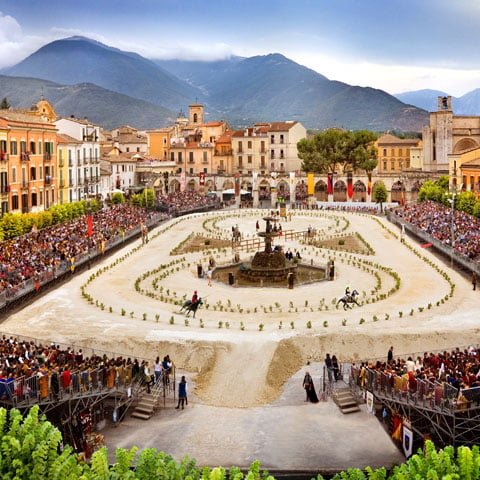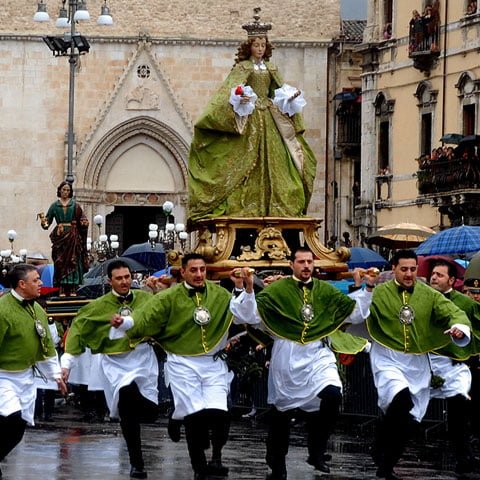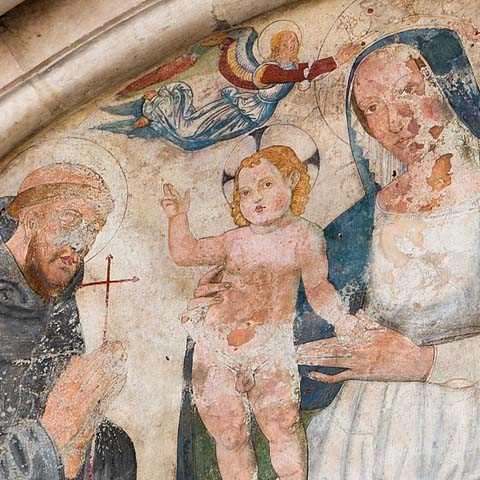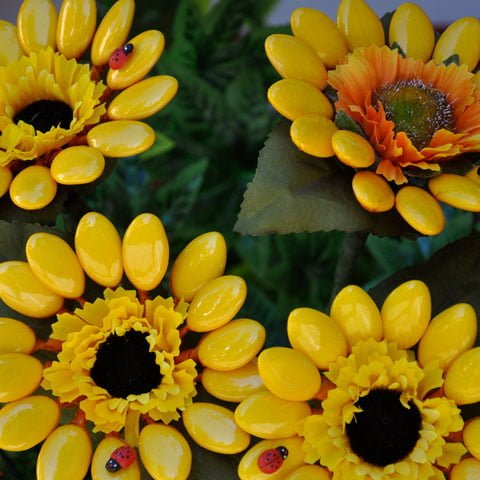The beautiful city of Sulmona is truly one of Italy’s best kept secrets. This small and enchanting city offers amazing architecture, art, music and more, all against the picturesque backdrop of majestic mountains and national parks. To properly soak in everything Sulmona has to offer, plan to spend some time sightseeing, learning the town’s history, and enjoying the warmth and graciousness of the people.
ARCHITECTURE
One of the more famous local landmarks of the city is the Sulmona aqueduct. This medieval structure was built in the mid-thirteenth century and features twenty-one beautiful stone arches. The aqueduct is a little over three hundred twenty feet long and historically was used to supply water to different areas of the town. In the late fifteenth century, a Renaissance style fountain featuring the Aragonese dynasty coat of arms was added at the northern end of the structure. A walk along this beautiful aqueduct is a must and offers several fabulous photo opportunities.
The Palazzo Annunziata and Chiesa della SS Annunziata are also popular stops. The gothic and Renaissance style palace was originally established as a hospital in the early fourteenth century. Although it did survive the early eighteenth-century earthquake, the building has required several updates and renovations over the years. The palace’s exterior features exquisite stone sculptures as well as ornate doors and windows.
The Museo Civico is located inside the Palazzo Annunziata and showcases various Roman history exhibits and artifacts such as prints, folk costumes, and objects pertaining to the local culture.
Perhaps the most frequented church in the city is the Sulmona Cathedral of San Panfilo. This eleventh century Roman Catholic church is the seat of the Bishop of Sulmona-Valva. The building’s site is thought to be even older than the structure as historians believe the church is built on top of the site of an ancient Roman temple. The cathedral originally had mainly Romanesque accents, but over the years through several renovations of the main church, it now features more of a Baroque style. The exterior of the church is quite simple, with no bells and whistles other than a large main door made of wood, an engraved archway that borders it, and a gorgeous fresco above it. The interior of the building is far more ornate with tall archways, a mosaic floor, and intricately detailed ceiling work. The church is lovely and evokes a sense of reverence amongst its visitors.
Sardi House once belonged to the Sardi Family who moved to Sulmona during the fifteenth century. Though its origins are not completely known, it is believed to have been enlarged by the family around the year 1477. The architecture of the building is tied to late Gothic culture and Renaissance architecture. Generally speaking, Sulmona offers many examples of Abruzzo’s style of Gothic architecture.
Oher historic palaces worth visiting in Sulmona include Alicandri Palace, Anelli Palace, and Corvi Palace.
ART
The Diocesan Museum of Sacred Art is one of Sulmona’s crown jewels. The museum is located in Piazza Garibaldi and is housed inside a structure that was formerly the Saint Clare Convent. The thirteenth century convent endured some renovations due in part to an earthquake in the early eighteenth century, but still holds much of its original charm. The museum is known for its large accumulation of various art mediums spanning hundreds of years beginning in the twelfth century, including canvas paintings, wooden sculptures, jewelry, textiles, and one of the oldest Franciscan codes on record. The museum’s two exhibition rooms are what was once the inner chapel of the convent.
Sulmona’s most famous local creations, confetti, are considered to be an art form by the locals. The confetti consist of almonds coated with sugar that are made in a variety of colors. Throughout Italy, important celebrations such as weddings, first communions, and other events are marked with confetti. In Sulmona, this is taken one step further with the locals creating colorful decorations, such as flowers, using confetti.
LITERATURE
Perhaps the single best and most well-known contributor to Sulmona’s literature is that of the Roman poet Ovid. Historians believe he was born in the city circa 43 BC. Ovid is thought to be one of only three canonical poets of Latin literature. Although he was generally popular with the people, a Roman military leader, Augustus, exiled him to a remote area of the Black Sea. His reasons for doing so are largely unknown, and the poet passed away during the time of his exile. One of Ovid’s most renowned works is The Metamorphoses, a fifteen-book mythological narrative written in the meter of epic.
Virgilia D’Andrea was an Italian poet of the early twentieth century. She was born in Sulmona and is best known there for her written work of Tormento, a book of poetry. A few years after completing the work she emigrated to the United States.
The Sulmona Municipal Library is dedicated to native Roman poet Ovid and features approximately 40,000 volumes from the sixteenth to the nineteenth centuries. Among the works held here are books on Abruzzo’s history, archeology, art and culture, as well as a collection of Ovid’s writings.
MUSIC
The Maria Caniglia Theater is one of the most famous Sulmona landmarks that supports the city’s musical history. It is the largest historical theater in the region of Abruzzo and is named after a female Italian dramatic soprano of the early twentieth century. The theater has experienced several periods of restoration and renovation over the years. The exterior of the structure is grand in a simplistic nature, and the interior of the theater is filled with rich color and luxurious accents.
The Camerata Musicale Sulmonese was established in the mid-twentieth century. The organization annually presents various musical concerts from the months of October to March in a variety of different venues.
CINEMA
Perhaps the most iconic symbol of Sulmona, the medieval aqueduct, is featured in a beautiful scene between actress Violante Placido and actor George Clooney in the 2010 movie The American. In it, the two actors are seated on the stone stairway that connects Piazza Garibaldi and Corso Ovidio. It is one of Sulmona’s finest moments in cinema.
In addition to The American, Sulmona has also been a backdrop for Italian pictures such as Fontamara (1977), Parenti serpenti (1992), Un Natale con I fiocchi (2012), Come il vento (2013), and Cloro (2015).
The Sulmonacinema Film Festival is an event that celebrates the art of motion pictures. The event explores international films but tends to focus on young Italian cinema. One of the highlights of this gathering is the feature film competition. Several Ovid awards are given for best film, best director, best actor, best actress, and best soundtrack.
SCIENCE
Travelers can visit Sulmona’s Natural History Museum to learn more about the local flora and fauna. Exhibits include a collection of local insects as well as fossils, minerals, and geodes.
Don’t delay another minute and make plans to lose yourself in the rich culture and tradition of the charming town of Sulmona, Italy.
Don't just see Italy, live it.
Your dream trip to Italy has never been closer
No more endlessly scrolling travel sites. Our travel experts will craft the perfect, one-of-a-kind trip just for you.

300+
DESTINATIONS
We offer more Italian destinations than any travel site. Do and see more with Trips 2 Italy.
1 (of a kind)
ITINERARIES
Because your dream trip to Italy should be designed for you, not for the masses.
100%
PEACE OF MIND
From flights and accommodations, to food and activities - we take care of every detail.







